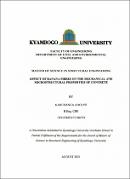Effect of banana fibers on the mechanical and microstructural properties of concrete
Abstract
This research presents an experimental study on the "Effect of Banana fibres on the
mechanical and microstructural properties of concrete". Concrete being a quasi-brittle
material, exhibits limited ability to restrict and reduce the generation and development
of cracks. Recently, Natural fibres with their principal raw materials being agricultural
wastes were found to be one of the suitable alternative cementitious reinforcing
material. The main objective of this research was to study the effect of Banana fibres
on the mechanical and microstructural properties of concrete; and the specific focus
was four-fold: Properties of banana fibres; properties of plain and Banana fibre
reinforced concrete (BFRC) in hardened state; and finally, behaviour of fibres in
concrete. A total of288 samples (cubes, beams and cylinders) ofC20/25 concrete mix
comprising of six (06) mixes for plain concrete (reference concrete) and BFRC, were
cast and tested in the laboratory at 14 and 28 days and the.behaviour of fibres in
concrete modelled using ABAQUS computer software. BFRC had two parameters that
were varied; fibre length (40 mm, 50 mm and 60 mm) and fibre content (0 .00%, 0.1 0%,
0.25%, 1.00%, 1.50%, and 2.50%). Findings revealed the following; the tensile
strength of banana fibres was 167. 89MPa; samples containing banana fibres
significantly impacted on the flexural and compressive strengths of concrete by 10 %
and 13% respectively; while a residual strength of up to 40% for BFRC was obtained.
The optimum fibre length was 40, and a lower fibre content of up to 0.25 % dosage.
Further, samples containing fibres improved the microstructure of concrete; evidenced
by a reduction in the interfacial transition zone of concrete (ITZ); no micro-cracks;
cement paste deposited on surfaces of fibres and fmally exhibited higher intensity than
plain concrete. ABAQUS FEM predictions on the representative volume element
(RVE) model using experimental test results revealed that samples containing fibers
were able to resist failure compared to plain concrete for both tension and compression
failure conditions. It was therefore concluded that the incorporation of Banana fibers
in concrete was found to improve on concrete properties at lower fibre content and
fibre length.

